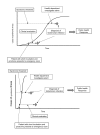Syndromic surveillance and bioterrorism-related epidemics
- PMID: 14609452
- PMCID: PMC3033092
- DOI: 10.3201/eid0910.030231
Syndromic surveillance and bioterrorism-related epidemics
Abstract
To facilitate rapid detection of a future bioterrorist attack, an increasing number of public health departments are investing in new surveillance systems that target the early manifestations of bioterrorism-related disease. Whether this approach is likely to detect an epidemic sooner than reporting by alert clinicians remains unknown. The detection of a bioterrorism-related epidemic will depend on population characteristics, availability and use of health services, the nature of an attack, epidemiologic features of individual diseases, surveillance methods, and the capacity of health departments to respond to alerts. Predicting how these factors will combine in a bioterrorism attack may be impossible. Nevertheless, understanding their likely effect on epidemic detection should help define the usefulness of syndromic surveillance and identify approaches to increasing the likelihood that clinicians recognize and report an epidemic.
Figures


Comment in
-
Syndromic surveillance.Emerg Infect Dis. 2004 Jul;10(7):1333-4. doi: 10.3201/eid1007.031035. Emerg Infect Dis. 2004. PMID: 15338541 Free PMC article. No abstract available.
References
-
- Mostashari F. BT surveillance in New York City. Presentation at the CDC International Conference on Emerging Infectious Diseases, 2002, Atlanta. [Cited January 2003] Available from: URL: ftp://ftp.cdc.gov/pub/infectious_diseases/iceid/2002/pdf/mostashari.pdf
-
- Wagner MM, Tsui F, Espino JU, Dato VM, Sittig DF, Caruana RA, et al. The emerging science of very early detection of disease outbreaks. J Public Health Manag Pract. 2001;7:51–9. - PubMed
-
- Centers for Disease Control and Prevention. Draft framework for evaluating syndromic surveillance systems for bioterrorism preparedness. [Cited December 2002] Available from: URL: http://www.cdc.gov/epo/dphsi/phs/syndromic.htm
-
- Committee on Science and Technology for Countering Terrorism, National Research Council of the National Academies. Making the nation safer, the role of science and technology in countering terrorism. Washington: National Academies Press; 2002. p. 74–6.
Publication types
MeSH terms
LinkOut - more resources
Full Text Sources
Other Literature Sources
Medical
